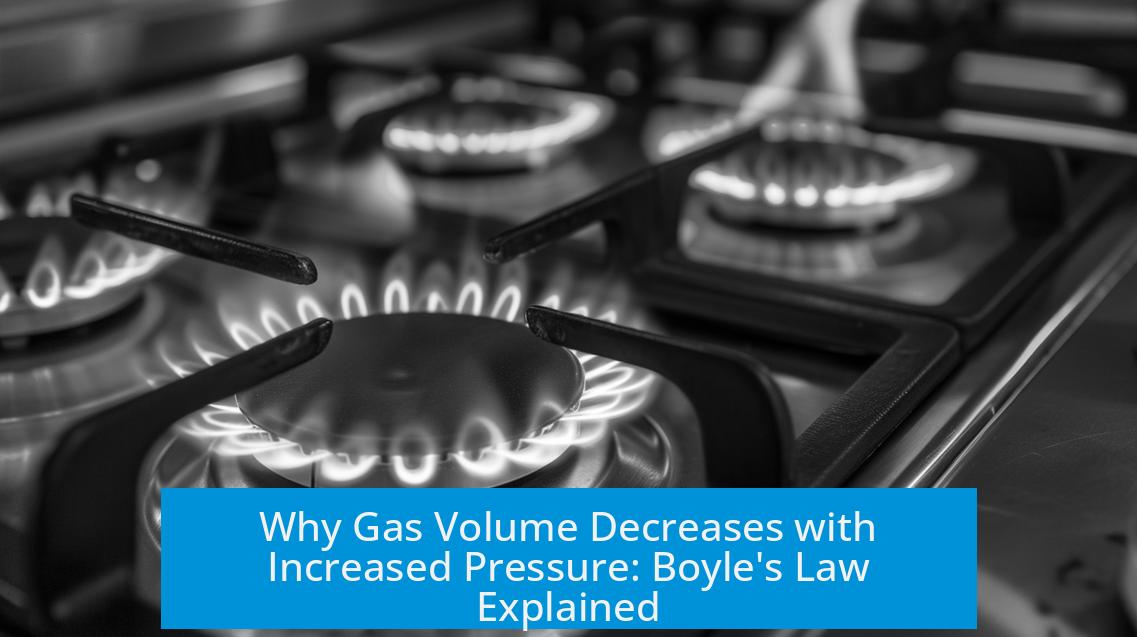Why Does the Volume of a Gas Decrease as Its Pressure Increases?

The volume of a gas decreases as its pressure increases because gas pressure and volume are inversely related when temperature and gas quantity remain constant. Increasing pressure means gas particles collide more frequently within a smaller space, reducing volume to balance internal and external forces.
Understanding the Macroscopic Relationship Between Volume and Pressure
Pressure in a gas arises from collisions of gas particles with the container walls. Each particle possesses momentum, the product of its mass and velocity. When particles collide more often or with higher momentum, the pressure increases.
- If the volume of the container decreases but the number of particles and temperature remain constant, the particles have less space to move.
- This leads to more frequent collisions between particles and with the container walls.
- As a result, measured pressure rises because of increased collision frequency per unit area.
Consider a sealed syringe containing gas. When the plunger is pushed inward, external pressure rises. The gas volume shrinks, causing gas particles inside to collide with the syringe walls more often, thus increasing internal pressure.
Equilibrium requires internal and external pressures to be equal. If internal pressure is lower than external, the gas compresses until balance is achieved, demonstrating why volume must decrease as pressure increases.
Thermodynamic Explanation Using the Ideal Gas Law
The behavior of gases under varying pressure and volume is modeled by the Ideal Gas Law:
PV = nRT
Here, P is pressure, V is volume, n is the number of moles, R is the gas constant, and T is temperature. For a fixed amount of gas (constant n) at a constant temperature (constant T), this equation simplifies to:
P ∝ 1/V
This means pressure is inversely proportional to volume. Decreasing volume causes pressure to rise proportionally, while increasing volume causes pressure to decline.
Thinking mathematically, if volume is the independent variable and pressure the dependent one, changing volume dictates the pressure due to the fixed nature of n and T. Physically, changing pressure without adjusting volume is impossible because pressure depends directly on particle collisions influenced by the space they occupy.
Microscopic View: Particle Collisions and Energy Exchange
At the molecular level, gas particles move randomly with certain velocities and masses. Their average kinetic energy corresponds to temperature. Collisions between particles and the container walls transfer energy but do not deform the container if rigid.
- Volume corresponds to the average distance a particle travels before colliding with another particle or the wall.
- Pressure reflects the number of collisions with the container wall per unit area over time.
- When volume decreases, particles have less room and collide more frequently with walls, increasing pressure.
This microscopic picture explains why reducing the volume forces particles closer together, making collisions more frequent and elevating pressure.
Container Flexibility and Pressure Balance
For gases in deformable containers, such as balloons or pistons, walls adjust until internal and external pressures match. If internal pressure exceeds external, the container expands, increasing volume until equilibrium is restored. Conversely, if external pressure is higher, the container compresses, reducing volume.
This interplay confirms the principle that volume changes respond directly to pressure differences, maintaining balance between forces.
Conceptual Summary and Boyle’s Law
Pressure indicates how densely packed gas molecules are. When they are forced closer by a decrease in volume, collisions increase, raising pressure. A simpler phrasing often improves understanding: “Decreasing the volume of a gas increases its pressure.”
Boyle’s law, a special case of the ideal gas law for constant temperature and amount of gas, expresses this relationship mathematically:
P1V1 = P2V2
According to Boyle’s law, if pressure doubles, volume halves, and vice versa, illustrating inverse proportionality with precise quantitative relationships.
Summary of Key Points
- Pressure results from gas particle collisions with container walls.
- Decreasing gas volume places particles closer together, increasing collision frequency and pressure.
- The ideal gas law (PV = nRT) governs the relationship; at constant n and T, pressure varies inversely with volume.
- Microscopically, less volume means shorter paths between collisions, leading to higher pressure.
- Containers balance internal and external pressures by changing volume accordingly.
- Boyle’s law quantitatively captures the inverse relationship between pressure and volume.
Why does gas volume decrease when pressure increases?
Gas particles collide more often when volume is smaller. More collisions with container walls increase pressure. To balance pressure inside and outside, volume contracts as pressure rises.
How does the ideal gas law explain the volume-pressure relationship?
The ideal gas law states PV = nRT. Holding moles and temperature constant means pressure is inversely proportional to volume. If volume goes down, pressure must go up.
What happens to gas particles inside a shrinking container?
Particles have less space and collide more frequently. These frequent collisions against the container walls cause pressure to increase as volume decreases.
Why does pressure rise when a piston compresses a gas?
Pushing the piston reduces gas volume. This forces particles closer, raising collision rates on walls, which causes pressure to increase.
Can pressure change without altering volume?
No. For fixed temperature and number of particles, pressure depends on volume. Changing pressure means volume must adjust accordingly.





Leave a Comment